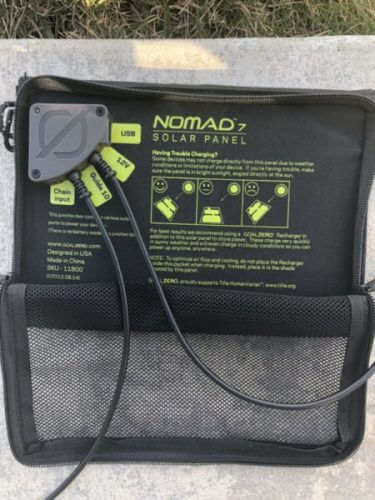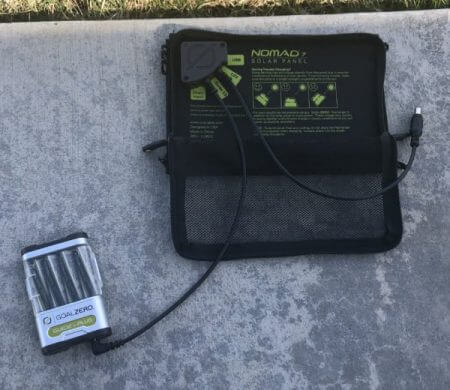The Goal Zero Nomad 7 Solar Panel and Guide 10 Battery Pack is an all-in-one package for people looking to charge electronics away from a regular power source. It can charge AA and AAA batteries, features a USB port that can charge directly from the solar panel, and USB items from the battery pack when there isn’t any sunlight available.
If you need more charging power, add more Goal Zero Nomad 7 solar panels and increase your charging speed.
Who Should be Interested in the Goal Zero Nomad 7 Solar Panel and Guide 10 Battery Pack?
Anyone interested in getting an all-in-one solar panel/battery pack should look at the Guide 10 Battery Pack and Nomad 7 Solar Panel.
- Charge phones and USB devices directly from the sun, featuring a dynamic auto-restart and...
- Easy-to-read LED indicator displays strength of solar conditions. Receive immediate feedback on...
- Detachable kickstand provides optimum angle placement, natural shade for charging devices and a...
- The Nomad 7 Plus features an auto restart that s smarter than anything else on the market. With the...
- You can plug your phone, camera, headlamp, etc directly into the panel or use it to recharge a power...
Features
The Guide 10 Plus Solar Recharging Kit and the Nomad 7 Solar Panel come at .8 lbs. When completely folded up, it measures 9.5″ x 1.5″ x 6.5″.
It is designed to operate between 0 and 120 degrees F, so it should be good in most environments. Just remember that batteries can burst when used in extreme heat, and batteries in cold environments often need to be warmed (body heat works great) before they function.
The Nomad 7 pairs well with the Lighthouse Mini Lantern.
The outer cover of the solar panel is made of a nylon material. It unfolds to reveal the two solar panels inside. I’ve found that the slight angle of the outer flap is great for angling the panels toward the sun to get the most out of daylight.
It also has several small bungee-style straps integrated into the panel, making it easy to hang off your pack. They could also be helpful in routing wires, but I’ve never felt a need to use them that way.
Mono-crystalline style panels are used in the Nomad 7 that are rated at 7W.

The rear of the Nomad 7 Solar Panel has a zippered mesh pocket that contains simple printed instructions inside, houses the outputs from the solar panel itself, and allows you to store any cables, needed for charging and the Guide 10 Plus.
Power is stored in this kit by Guide 10 Plus. It uses either 4 AA or 4 AAA batteries to hold its power. Any rechargeable AA or AAA battery can be used in Guide 10.
The Guide 10 has a dedicated power cord from the solar panel and fits neatly inside the back pocket.
The kit comes with a 12V cable, a USB cable, and the AAA battery inserts for the Guide 10 Plus.
It should be noted that if you buy the Nomad 7 alone, it does not store power. You can still charge devices and other USB battery packs from it, but the Nomad 7 is only a solar panel with no batteries.
Charge times for items attached to the Nomad 7 are 2-4 hours for the Guide 10 and 1-3 hours for a phone. The Guide 10 can also charge from a USB port which takes about 8 hours.
Most Popular Portable Solar Panels
Pros
I like the versatility of the Nomad 7 when it’s paired with the Guide 10. This is where the Goal Zero product line shines. They’re all designed to be used together without any possible compatibility issues.
The Goal Zero Nomad 7 Solar Panel and Guide 10 Battery Pack hit the sweet spot for portable, on-the-go solar. Any larger, and they’d get in the way. Any smaller, and you’re looking at 8 hours to charge a similar size battery pack and close to 6 hours to charge a phone.
The fact that it’s just two panels is light has an integrated pocket for the battery pack, and has the little bungees make it nice to hang off of a pack. The only thing that would make it better is flexible solar panels.
An option built into the Nomad 7 is the ability to chain up to four Nomad 7s to increase the charging capacity. This is nice if you have multiple people carrying these, but adding more than one Nomad 7 to a bug-out bag would take away from the main benefit of this solar kit.

Cons
Some cell phones may not be able to charge directly off of the solar panel. This is because they require a continuous power source that doesn’t fluctuate as solar power can. If you run into this, you must charge your device off the battery pack itself.
While the Guide 10 Plus Solar Recharging Kit and the Nomad 7 Solar Panel are technically weather-resistant, you need to remember that there are exposed USB cables and charging ports on the back. I’ve been very careful when it rains lightly and haven’t had problems. The panels themselves wipe off without a problem.
If you’re rough with the panels, you could break them. This will be the case for any panel of this type, but it still deserves to be mentioned.
Conclusion
For someone looking to charge a handful of electronic devices on the go, the Goal Zero Nomad 7 Solar Panel and Guide 10 Battery Pack make a lot of sense. If you’re looking for a solar panel to break out during a power outage in your home, you should look for something larger without the limitation of only having two solar panels.
There is also an updated version of this kit: Goal Zero Guide 10 Plus Kit with Nomad 7 Plus Solar Panel. I don’t have one to review, so you’ll have to research it. It looks like the main difference is it’s a little lighter, and the pocket area has a stand that pops out to make standing it up easier.





